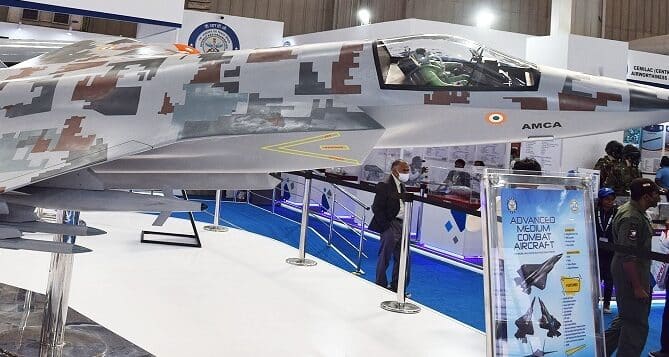Aerospace
5th generation fighter jet AMCA project gets Cabinet Committee on Security approval

India has officially embarked on the development of the Advanced Medium Combat Aircraft (AMCA) with the approval of funding by the Government of India for the fifth-generation fighter jet program. According to government sources, this cutting-edge aircraft will be a collaborative effort between Hindustan Aeronautics Limited (HAL) and the National Aerospace Laboratories (NAL).
The Cabinet Committee on Security, chaired by the Prime Minister of India, has given its green light to the indigenous fifth-generation Advanced Medium Combat Aircraft (AMCA) fighter jet project for the Indian Air Force (IAF), with a budget of USD $1.8 billion. The approval entails the preparation of five prototypes of the AMCA, which will be undertaken by the Defence Research and Development Organisation (DRDO) over the course of the next five years.
India’s much-anticipated AMCA project marks a significant leap forward in bolstering the country’s defense capabilities, propelling it to new heights on the battlefield with cutting-edge 5th generation fighter jet aircraft. Building on the success of the Tejas Mark1 aircraft, which has already left a substantial impact on India’s defense prowess, the AMCA represents the next frontier in India’s quest for technological excellence and military superiority.
The futuristic AMCA boasts a design featuring shoulder-mounted diamond-shaped trapezoidal wings, strategically crafted to minimize drag during transonic speeds. Its stabilatorV-tail, coupled with a large fuselage-mounted tail-wing, ensures optimal stability and maneuverability. Flight control surfaces including flaps, ailerons, and rudders, alongside innovative air brakes, further enhance its performance.
In a groundbreaking leap towards sixth-generation capabilities, the AMCA is envisioned to embrace crew-optional configurations and wield directed energy weapons, effectively commanding UCAVs and swarm drones.
Propelled by two afterburning turbofan engines, the AMCA Mark-1 is set to be equipped with the formidable General Electric F414 engine, while a joint venture engine of heightened power is earmarked for the AMCA Mark-2 variant.
Anticipated to revolutionize aerial reconnaissance, the AMCA will integrate distributed passive sensors, empowered by AI-assisted multi-sensor data fusion, augmenting situational awareness alongside an advanced electronic warfare suite.
Inside the cockpit, innovation takes center stage with a sleek glass cockpit adorned with a panoramic touchscreen display, fostering seamless man-machine interaction. Complemented by a portrait-oriented multifunction display and a wide-angle holographic head-up display, pilots are equipped with unprecedented visibility and control.
With the recent debut flights of South Korea’s KF-21 and Turkey’s TFX, the anticipation grows around India’s potential entry into the league of advanced 5th generation fighter jets. The AMCA, undergoing testing with GE engines initially, holds promise for upgraded features powered by higher-capacity engines in the future. While many countries have expressed interest in joining India’s 5th generation fighter jet program, India has chosen to pursue its advanced aircraft development independently.
India’s commitment to its indigenous Fifth Gen Fighter jet program positions it uniquely on the global aerospace stage, showcasing its prowess in producing cutting-edge aircraft. This strategic move not only boosts India’s defense capabilities but also promises economic growth through advancements in the aerospace sector.

Aerospace
When Ratan Tata was denied entry to the airfield at the Aero India show, he waited

During our visit to Aero India 2019, we had the unexpected opportunity to see Ratan Tata at the event, which was a thrilling moment for us. However, there was a surprising hiccup when the security staff didn’t allow him to enter due to a lack of a security pass.
Despite this, he remained calm and patiently waited for about 20 minutes until a member of the Tata team brought him the required pass, after which he calmly proceeded inside. It was a humbling sight, showcasing his composed demeanor even in such situations.
Ratan Tata ji is not only a renowned industrialist but also a trained pilot, holding a pilot’s license. In 2007, he became the first Indian civilian to fly the F-16 Falcon during the Aero India show in Bangalore—a proud moment for the nation.
His passion for aviation extended beyond flying, as he played a key role in shaping India’s aerospace industry. Under his leadership, Tata ventured into manufacturing and maintaining aerospace components while upholding its legacy of quality. Notably, Tata’s collaboration with Airbus to develop and manufacture the C295 aircraft is a testament to its growing influence in the sector.
-

 Aviation2 months ago
Aviation2 months agoMicrosoft Flight Simulator Raises $3 Million to Bring Back the An-225 Mriya
-

 Airlines2 months ago
Airlines2 months agoQatar Citizens Can Travel to the United States Without a Visa
-

 Aviation2 months ago
Aviation2 months agoQatar Airways bans these new Electronic Devices on plane
-

 Defence2 months ago
Defence2 months agoWhich Country Has the Largest Fleet of Fighter Aircraft?
-

 Airlines5 days ago
Airlines5 days agoDAMAC Air: Dubai’s New Luxury Airline Offers Free Flights for Registration
-

 Airport2 months ago
Airport2 months agoWestern Sydney Airport Welcomes Its First Plane After 6 Years of construction
-

 Airlines4 days ago
Airlines4 days agoAir India to Launch aircraft maintenance training institute in Bengaluru
-

 Aviation2 months ago
Aviation2 months agoDid you know ? Once Boeing 747 carried 1088 passenger in 1991








